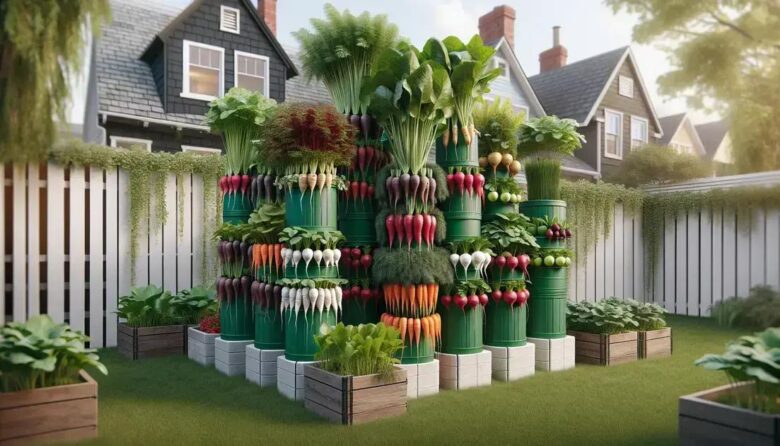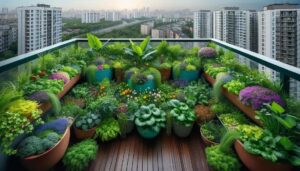Ever wondered how to maximize your garden space with root vegetables? Using tall container towers might be the innovative solution you’re looking for. These vertical gardens can transform small areas into thriving root veggie paradises. Let’s explore this unique growing method.
why choose container gardening for root vegetables
Container gardening is a versatile and space-efficient method for cultivating root vegetables. It allows you to control soil quality, moisture, and sunlight exposure, thus optimizing the growing conditions. One of the main advantages is the ability to garden in small or unconventional spaces, such as balconies or patios.
Space Efficiency
Using containers allows gardeners to stack their plants vertically, making the most out of limited space. This method is particularly beneficial for urban dwellers with restricted garden areas.
Soil Control
Containers give you complete control over the soil’s composition. This is crucial for root vegetables, which thrive in well-aerated and nutrient-rich soil. You can customize your soil mix to suit each type of root vegetable, ensuring a healthy yield.
Pest Management
Raised containers help prevent pests that are typically found in the ground. By elevating plants, you reduce the chances of soil-borne diseases and pests reaching them, which is vital for maintaining healthy crops.
Ease of Maintenance
Another benefit of container gardening is the ease of maintenance. With a container system, it’s easier to water and fertilize, and you can move plants to better-suited locations as seasons change.
In conclusion, container gardening is an innovative choice for those wanting to grow root vegetables but are limited by space. With its ability to maximize efficiency and yield, this method can help you maintain a productive and rewarding garden.
best root vegetables for container towers
When it comes to choosing the best root vegetables for container towers, you have several great options. These plants thrive in vertical setups due to their compact root systems and adaptability. Let’s look at some popular choices:
Carrots are a favorite for container gardening. They require deep, loose soil to grow straight and long. Look for varieties like ‘Nantes’ or ‘Chantenay’ that are well-suited for tall containers.
Radishes grow quickly and are perfect for beginners. With a short maturity period, you can enjoy fresh radishes in a matter of weeks. They don’t need much depth, making them ideal for any part of your container tower.
Beets are another excellent choice, appreciated for their dual-purpose leaves and roots. They flourish in containers with at least 12 inches of depth to accommodate their bulbous roots.
Turnips grow efficiently in containers and offer both nutritious greens and roots. They prefer cooler temperatures, so place them in shaded areas if your tower is in a sunny spot.
Parsnips require a bit more patience due to their long growing season. However, they reward gardeners with sweet, nutty flavors that are perfect for soups and stews.
building your own container towers at home
Building container towers at home is a rewarding project that allows gardeners to maximize their space vertically. This DIY solution is perfect for growing root vegetables and other plants while adding a decorative element to small gardens or balconies.
Materials Needed include sturdy containers like buckets or pots, a vertical support structure such as a wooden frame or metal poles, soil, and your choice of plants. Make sure each container has adequate drainage holes to prevent waterlogging.
Assembling the Tower involves placing your containers securely onto the support structure. Ensure they are stable and will not tip over by stacking them in a pyramid shape or securing them with ties if necessary.
Choosing the Right Location is crucial for success. Place your tower in an area that receives adequate sunlight, at least 6-8 hours a day. If possible, position it where it is sheltered from strong winds.
Planting your vegetables and herbs in layers is key. Place plants that require more sun at the top and those preferring shade toward the bottom, allowing you to make the best use of the available light.
soil requirements and planting tips
Selecting the right soil is crucial for the success of your container tower garden filled with root vegetables. To achieve optimal growth, use a well-draining, nutrient-rich soil mix. A combination of high-quality potting soil, compost, and perlite works well.
Soil Composition should be lightweight to allow for adequate drainage and root expansion. Mixing compost into the soil provides the necessary nutrients and helps retain moisture.
Moisture Levels are vital. Root vegetables do not thrive in soggy conditions, so ensure your containers have drainage holes. Regularly monitor the soil moisture by touching the top inch; it should feel moist, but not waterlogged.
Planting Depth depends on the type of root vegetable. For example, plant carrot seeds about 1/4 inch deep, while beets and radishes prefer sowing at a slightly deeper depth, around 1/2 inch.
Spacing is important to prevent overcrowding. Give each plant enough room to develop without competing for nutrients. For instance, leave about three inches between carrot plants and five inches for beets.
Sunlight is crucial. Position your towers to ensure the maximum amount of sunlight, ideally around 6-8 hours per day. Adjusting the towers periodically can help achieve this.
watering and maintenance for tall towers
Proper watering and maintenance are essential for the success of your tall container towers, especially when growing root vegetables. Understanding the unique needs of your vertical garden helps maintain healthy plants.
Watering Techniques require consistency. Root vegetables need moist but not waterlogged soil. Water early in the morning to allow moisture to reach deep roots before the midday sun raises temperatures.
Drip Irrigation Systems can be a great investment. These systems ensure even watering across all levels of your tower, saving you time and preventing under or over-watering.
Regular Checks are vital. Inspect your garden weekly for signs of pests or diseases. Yellowing leaves or stunted growth can indicate problems that need to be addressed promptly.
Pruning and Thinning guarantee better growth. Remove any dead foliage and thin crowded plants to improve air circulation and reduce the risk of plant diseases.
Fertilization is important. Container gardens can lose nutrients faster than ground soil. Use a balanced, slow-release fertilizer to keep your plants nourished throughout their growing seasons.
harvesting and maximizing yield
Harvesting root vegetables from your container towers can be both rewarding and straightforward if done correctly. Knowing the right time and method ensures a bountiful yield and keeps your plants healthy.
Timely Harvest is crucial. Check maturity dates for each vegetable type. Carrots are usually ready in about 70-80 days, while radishes can be harvested in as little as 25 days. Use days-to-maturity information provided on seed packets as a guideline.
Signs of Readiness include visible shoulders of the root above the soil, vibrant color, and a firm feel when gently squeezed. If in doubt, gently dig around one or two roots to ensure they are the desired size.
Harvesting Technique involves loosening the soil around the roots before pulling them out. Use tools carefully to avoid damaging the vegetables. It’s best to harvest during dry weather to prevent excessive soil clinging to the roots.
Post-Harvest Care is important for maximizing the flavor and storage life of your vegetables. Gently brush off excess soil and remove the foliage, leaving about an inch of stem on



